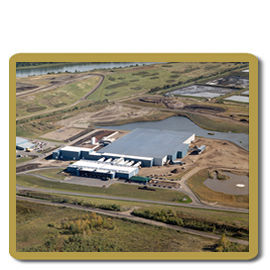

"Recognizes excellence in the application of engineering, geological and geophysical methods towards preservation of the environment and the practice of sustainable development."
Edmonton Co-Composting Facility
The Edmonton Co-Composting Facility, owned and operated by TransAlta Energy Marketing Corp., provides the City of Edmonton with a long-term, environmentally sound cost-effective solution to the problem of municipal waste management. The facility, which commenced operation in March 2000, transforms Edmonton's waste into compost, a valuable soil amendment.
Combined with Edmonton's recycling programs, this facility will help Edmonton divert close to 70% of residential waste from landfill, making Edmonton the first major municipality in Canada to meet or exceed the national target of 50% diversion. In addition to the environmental benefits, this facility will stabilize Edmonton's residential waste disposal cost for the next 30 years.
Roughly equal to eight football fields in size, the Edmonton Co-Composting Facility is designed to process 195,000 tonnes of municipal solid and 22,500 tonnes of dry municipal sewage sludge into 125,00 tonnes of cured compost product per year. With a design capacity of 1,100 tonnes per day, it is the largest facility of its kind in North America and one of the largest in the world.
The project presented some unique challenges, which were ultimately solved through the application of engineering expertise. Odor management was a challenge and therefore, was given prime consideration by the engineering team at each stage of design development. One leading edge design feature was a negative aeration system incorporated to ensure that odors within the vicinity of the facility were within acceptable limits. The system draws process air through the entire facility, down through the compost piles and through a scrubbing system, and biofilter prior to release into the atmosphere.
Having the facility located in a northern climate also posed unique engineering problems to overcome. One of these is the seasonal variation in waste characterization. Another cold climate concern is ensuring that microorganisms involved in the composting process are maintained in an environment suitable for their existence. To ensure this, as well as control the escape of odors, the entire composting process takes place within an enclosed space, making the aeration hall the largest stainless steel building in North America.
Through the integration of composting science and state-of-the-art engineering, the Edmonton Co-Composting Facility represents a major advancement in composting technology. The benefits of this project to the preservation of the environment include reducing the dependency on landfill, reducing methane production from landfill waste and producing quality compost for use in agricultural, landscaping and soil reclamation applications.